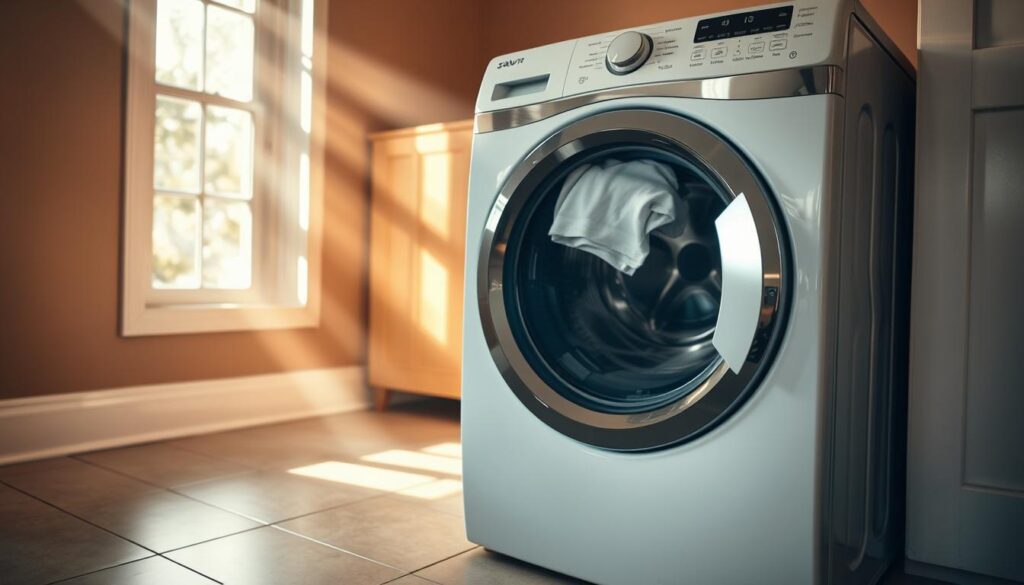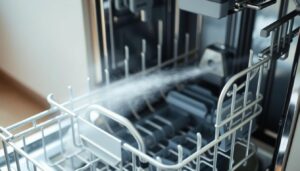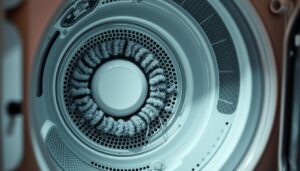Is your dryer disturbing the peace with an annoying thumping noise? You’re not alone. Many homeowners face this frustrating problem, and it’s often a sign of an underlying issue that needs attention.
The thumping noise can be caused by various factors, ranging from an unbalanced load to worn-out parts. Ignoring this problem can lead to more severe damage and costly repairs. Fortunately, many causes can be addressed through DIY solutions, and proper maintenance can prevent such issues from arising in the first place.
Key Takeaways
- Identify the common causes of a dryer making a thumping noise.
- Learn how to diagnose the problem and potential DIY fixes.
- Understand the importance of regular maintenance to prevent such issues.
- Discover when it’s necessary to seek professional help for repairs.
- Explore tips to extend the life of your appliance.
Why Your Dryer Is Making That Annoying Thumping Sound
A thumping sound from your dryer can be perplexing and is often a sign of a mechanical problem. Normally, a dryer operates smoothly, with its drum rotating consistently. However, when it starts making a thumping noise, there’s usually a disruption in this rotation.
The dryer’s drum is supported by various components, including rollers and a drive belt, which work together to ensure smooth operation. If the dryer is making thumping sounds, it could be due to an imbalance or a fault in these components.
- The thumping noise might be caused by balled-up towels or heavy objects in the drum.
- Occasional thumps can indicate a minor issue, while consistent thumping patterns suggest a more serious problem.
- The age of the dryer can influence the type of noises it makes and the likely causes.
Thumping differs from other dryer noises like grinding, squealing, or rattling. It’s often rhythmic and coincides with the drum’s rotation, aiding in diagnosis. Identifying the exact cause is crucial for an effective solution.
| Dryer Noise | Possible Cause |
|---|---|
| Thumping | Imbalanced drum or faulty rollers |
| Grinding | Worn-out bearings or damaged idler pulley |
| Squealing | Damaged drive belt or worn-out idler pulley |
Understanding the mechanics of your dryer and the nature of the noise it’s making is the first step towards resolving the issue. Whether it’s a simple fix or requires professional attention, diagnosing the problem correctly is key.
Common Causes of a Dryer Making Thumping Noise Fix
If your dryer is making a thumping noise, it’s essential to identify the root cause to prevent further damage. Several components within your dryer could be responsible for this issue.
Worn-Out Drum Rollers
The drum rollers play a crucial role in supporting the dryer drum. Over time, these rollers can wear out due to continuous use, leading to a thumping noise as the drum rotates. Worn-out rollers fail to provide the smooth rotation needed, causing the drum to vibrate and produce noise.
Damaged Drive Belt
A damaged or frayed drive belt can also cause your dryer to make a thumping noise. As the belt deteriorates, it can lead to irregular drum movement, resulting in the thumping sound. Inspecting the drive belt for signs of wear and tear is crucial in diagnosing the issue.
Flattened Rollers from Disuse
If your dryer has been sitting unused for a while, the rollers might become flattened, leading to a thumping noise when you restart the dryer. This flattening occurs due to the prolonged pressure on the rollers, causing them to lose their original shape.
How to Diagnose the Source of Your Dryer’s Thumping
If your dryer is making a loud thumping noise, it’s essential to diagnose the issue promptly to avoid further damage. Diagnosing the problem involves a combination of visual inspections and careful observation of the dryer’s operation.
Visual Inspection Steps
To start diagnosing the issue, unplug your dryer and disconnect the air vent duct if necessary. Remove the front or lower access panel to inspect the internal components. Check the drum rollers and the drive belt for any signs of wear or damage. If your dryer is hardwired or gas-powered, consider consulting a professional for assistance.
Listening for Specific Sound Patterns
Pay attention to the sound patterns of your dryer’s thumping noise. Is the thumping consistent or intermittent? Does it occur at specific points in the cycle? Listening carefully can help you identify whether the issue is related to the drum, rollers, or another component. Manually rotate the drum to check for resistance or irregularities, and ensure the dryer is properly levelled to prevent unnecessary vibrations.
Simple Fixes You Can Try First
You don’t necessarily need to call a repair service immediately if your dryer is making a thumping noise; try these simple solutions first.
Check for Balled-Up Clothing Items
Sometimes, large fabric items like sheets or curtains can roll up into a ball inside your dryer, causing it to vibrate or make a thumping noise. To resolve this, check on these items frequently and untangle any knots you find. This simple step can help your clothes dry faster and eliminate the thumping sound.
Ensure Your Dryer Is Level
An unbalanced dryer can also cause thumping noises. Check the levelling feet of your appliance to ensure it’s properly balanced on the floor. Adjust the feet as necessary to stabilise the dryer.
Run an Empty Cycle to Reshape Rollers
If you haven’t used your dryer for a long time, the rubber rollers might have flattened where they touch the drum, leading to a thumping sound. Running an empty cycle can help reshape these rollers. Once the dryer has run for some time, the rollers should regain their original shape, and the thumping should stop.
| Simple Fix | Description | Benefit |
|---|---|---|
| Check for Balled-Up Clothing | Untangle large fabric items | Faster drying and less noise |
| Ensure Dryer is Level | Adjust levelling feet | Reduced vibration and thumping |
| Run Empty Cycle | Reshape flattened rollers | Elimination of thumping noise |
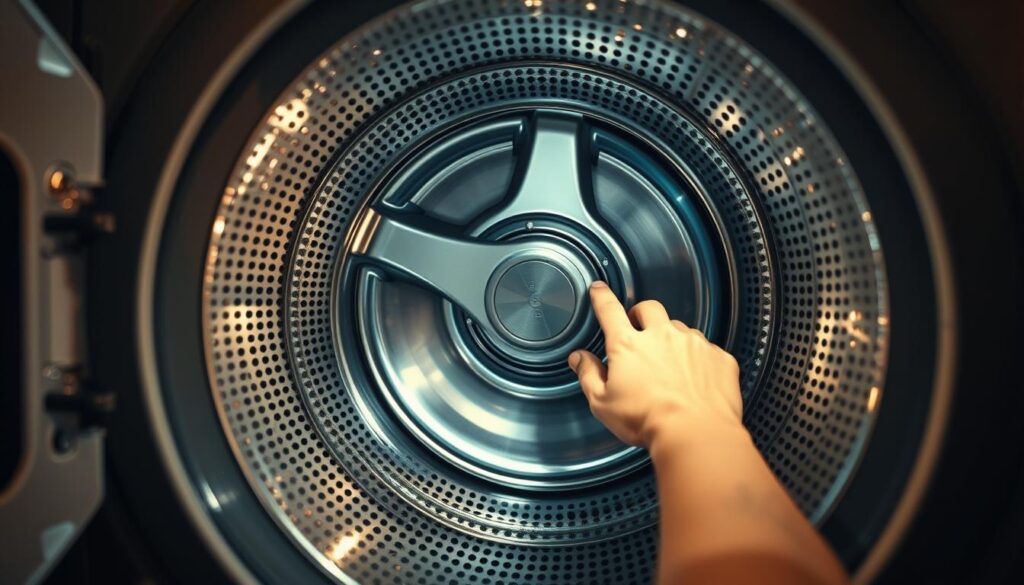
Repairing Worn-Out Drum Components
The drum of your dryer is supported by various parts, and when these parts wear out, you may hear a thumping sound. The drum rollers and axles are crucial for the smooth operation of the dryer drum. When these components become worn or damaged, they can cause the drum to vibrate unevenly, leading to the thumping noise.
Replacing Drum Rollers and Axles
To replace the drum rollers and axles, you will first need to access the drum by removing the front or rear panel of the dryer, depending on the model. Once you have access, you can remove the worn-out rollers and axles. It’s recommended to replace all rollers and axles at once, even if only one appears damaged, to ensure even wear and prevent future issues. Use a suitable tool to remove the old parts and install the new ones, making sure they are properly aligned.
Fixing or Replacing the Drum Seal
The drum seal is another critical component that can cause a thumping noise if it’s worn out. To fix or replace it, you’ll need to inspect the seal for any signs of damage or wear. If it’s damaged, you’ll need to source a replacement seal compatible with your dryer model. Removing the old seal and installing a new one requires care to ensure it’s properly aligned and not damaged during the process. Regular maintenance can help extend the life of the new seal.
Addressing Drive Belt and Pulley Issues
To address the thumping noise, inspecting the drive belt and pulley system is essential. The idler pulley plays a crucial role in maintaining tension on the drive belt, ensuring it doesn’t slip during operation.
Inspecting the Idler Pulley
To inspect the idler pulley, you’ll need to access it, usually by removing the back panel of your dryer. Check for signs of wear or damage, such as cracks or excessive wear on the pulley wheel. Test the pulley tension and movement by applying gentle pressure; it should move smoothly and maintain tension.
Replacing a Damaged Drive Belt
Replacing a damaged drive belt involves removing the old belt and installing a new one. Ensure the new belt is correctly routed around the drum, motor pulley, and idler pulley. Adjust the belt tension properly after installation. It’s crucial to select the correct replacement belt for your specific dryer model to avoid further issues.
| Component | Inspection Criteria | Action Required |
|---|---|---|
| Idler Pulley | Signs of wear, cracks, or excessive wear | Replace if damaged |
| Drive Belt | Cracks, frays, or excessive wear | Replace if damaged |
| Motor Pulley | Signs of wear, misalignment | Adjust or replace if necessary |
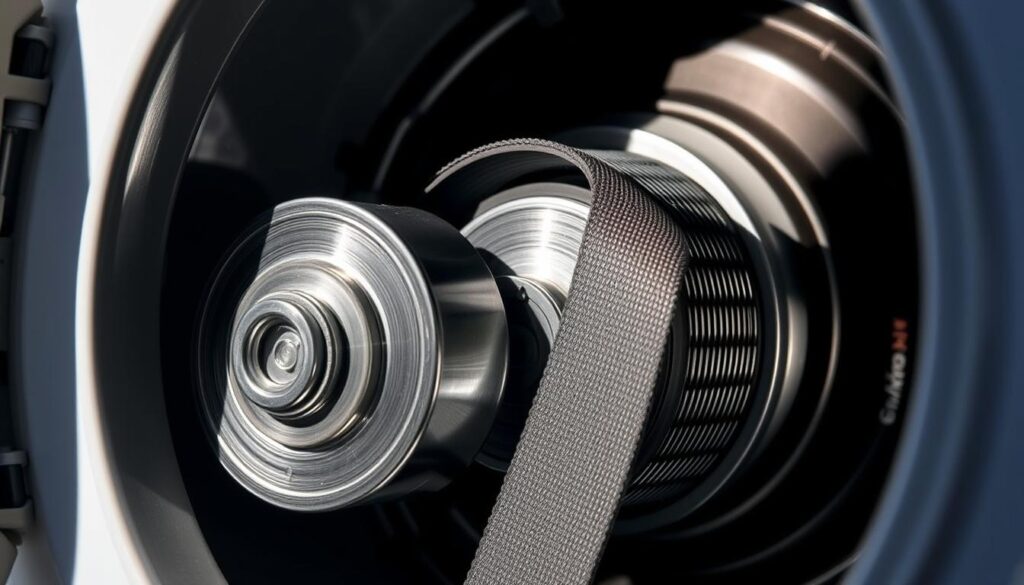
To extend the life of new belts and pulleys, ensure proper dryer use and maintenance. Regularly check and clean the drive belt and pulley system to prevent debris buildup.
When to Call a Professional Repair Service
Identifying the right time to seek professional repair services for your dryer can save you time and money. While some issues can be resolved with DIY fixes, more complex problems require expert intervention.
Signs of Serious Mechanical Problems
If you notice any of the following signs, it’s likely that your dryer needs professional attention: unusual noises, such as squealing or rattling, which could indicate a problem with the drive motor or blower wheel. A faulty drive motor can cause significant damage if not addressed promptly.
Gas Dryer Safety Considerations
For gas dryers, safety is a paramount concern. If you suspect a gas leak or notice signs of wear around the gas connections, do not attempt to repair it yourself. Instead, contact a qualified appliance repair professional to ensure your safety and the safe operation of your dryer.
| Issue | Typical Repair Cost | Recommended Action |
|---|---|---|
| Drive Motor Replacement | £150-£300 | Professional Repair |
| Gas Connection Repair | £100-£200 | Professional Repair |
| Dryer Drum Replacement | £200-£400 | Consider Replacement |
When deciding whether to repair or replace your dryer, consider the age and condition of the appliance. For older models, replacement might be more economical than repair.
Conclusion: Keeping Your Dryer Running Smoothly
When your dryer starts making thumping noises, it’s time to take action to prevent further damage. The main causes of these noises include worn-out drum rollers, a damaged drive belt, and flattened rollers from disuse. Addressing these issues promptly can prevent more serious problems, such as a burnt-out motor. Regular maintenance, like checking and cleaning key parts, can also help extend the life of your dryer. By being proactive, you can ensure your appliances continue to run smoothly, saving you time and reducing wear and tear.
To keep your dryer in good condition, ensure proper loading and operation, and consider keeping the user manual handy for troubleshooting. If you’re dealing with a very old or repeatedly problematic dryer, it may be worth weighing repair costs against replacement. With the right approach, most thumping issues can be resolved, getting your laundry routine back on track.
